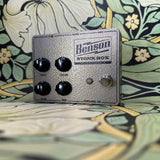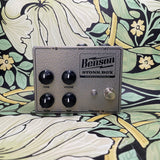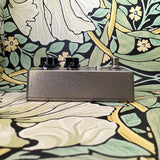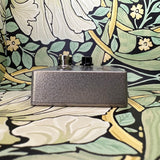Like the Germanium Fuzz before it, the Stonk Box attempts to take a classic 1960’s fuzz design, and bring the sound into the modern world without bringing any along the flaws and inconsistencies of the original. In this case, Benson set their eyes on the MK1 fuzz (which is itself a modified version of the very first fuzz ever). They kept the original controls (FILTER and VOLUME), and added a TONE control and a TRIM control to expand the palette of sounds available. Buffer and pedal order friendly (but with no pickup simulation, we had to tweak the output circuit this time). The original circuit is considered one of the hardest of the classic fuzzes to get right because of the difficulty in transistor selection...with Benson's patented technology they can do it easily and consistently...for the first time ever!
AUTOMATIC THERMAL BIAS TECHNOLOGY
The bias of the transistors in this pedal is automatically regulated by a circuit that GENTLY warms the Germanium transistors (2N404 OR 2N527) to a preset operating point using analog components, and ensures a consistent sound, no matter the external temperature. When the LED is amber, the transistors are warming up to increase their hFE (transistor gain) and to shift the bias point to the correct voltage. When the LED turns green, the warmer is off because the correct bias and hFE have been set. Expect the LED to toggle back and forth every so often while the pedal is on...that is how you know its working. The heaters will warm the transistors enough to still be effective on a summer stage, but far cooler than anything that would harm the transistors. This pedal is designed to operate between freezing and 100F but might still sound fine outside this range....up to about 120F where we’ve found germanium straight up ceases to function...which can happen if it’s left in the sun.
CONTROLS
TRIM is a gain control right before the two amplifying germanium transistors...turned all the way up is how the stock design is all the time.
FILTER manipulates both the gain and the bias point of the first gain stage. When turned down it will take away gain, bass frequency response, and will bring in to a gentle dynamic expander type effect (where quiet notes will be quieter than normal, the opposite of a compressor) TRIM and FILTER are interactive and there are many different flavors of fuzz and distortion to dial in. This pedal will not clean all the way up, even at low trim volumes there will be some distortion (in a nice way). This control will crackle a bit when turned, since there is some DC across it.
TONE is a low pass filter at the end of the circuit, carefully designed to act almost like a tilt EQ to balance the bright attack and full body of the sound, made possible by the original circuit being WAY brighter than the bypassed guitar signal...we think they’ve struck a good balance here.
VOLUME is the output level...which we’ve increased many orders of magnitude from the original. We took the training wheels off so you can push the front end of your amp into sonic madness (if you want). NOTE: this user-beware approch can also lead to settings with a high noise floor. Please remember, this is a crazy and primitive fuzz at its heart...not a piece of pristine recording equipment. Let’s just say there were good reasons for the next four historic revisions of this particular product. If you are concerning people with a high level of hiss and noise, that’s a feature not a bug. It’s fuzz.












